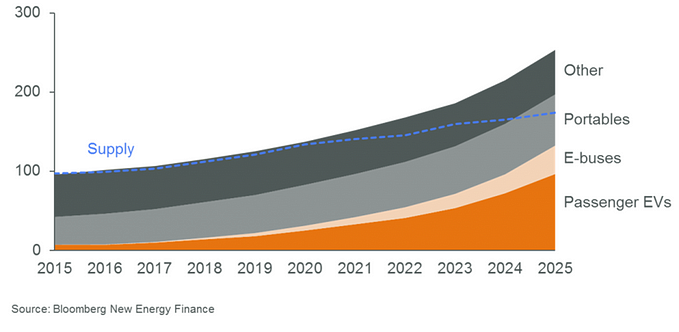Middle vs. Last Mile Drone Delivery: Which Will Scale Sooner?
There are well over 300,000 commercially registered drones in the US supporting industries like mapping, agriculture, renewable energy, and insurance. The promise of using autonomous aircraft for logistics has been on the horizon for some time given the potential to make our supply chains shorter, faster, and more efficient. The G2 team debates whether this promise is finally approaching reality after years of underwhelming commercial progress, and where drones will have a first major impact when it comes to the movement of goods (i.e. middle vs last mile).
First, what is the difference between “middle-mile” vs “last-mile drone” delivery?
- Middle-mile: Drones designed for longer range (up to 500 mi), higher payload (up to a few hundred pounds) deliveries between ports and distribution facilities.
- Last-mile: Drones designed for shorter range (1–3 mi), smaller payload (<15 lbs) deliveries from businesses (e.g., restaurants, grocery stores, etc.) to end consumers.
Zach: First up — delivering burritos and batteries — rapid delivery of consumer goods will be the first “real” industry for drones.
- Drones enable unheard-of speed. They can travel as fast as cars (30+ mph), but can also fly directly, never hit traffic or stop lights, and don’t get lost. From single locations, drone delivery businesses can serve entire surrounding areas with delivery in minutes. Companies promising 10-minute or less delivery with couriers on e-bikes have raised billions of dollars in venture funding and sold billions of dollars of goods, proving consumers want this service, but were plagued by inefficient operations, poor unit economics, and inconsistent service.
Despite their small size, drones are actually perfect for e-commerce deliveries. 75–90% of Amazon e-commerce deliveries are under 5 lbs, well within the payload capacity of most early delivery drone operators.
- Finally, this has potential to be a “magical” moment, in the same way that a consumer’s first ride on an Uber changed mobility for them, or their first Instacart order changed weekly grocery shopping, a first drone delivery from companies like Flytrex, DroneUp, or Matternet, arriving by air minutes after placing an order, could change the way that people think about e-commerce and meal delivery.
Jake: The easiest industry to forecast in the near term is the industry that already exists
- Middle-mile logistics is the unsung hero of home delivery. While the “last mile” is more visible to consumers, it is dependent on an efficient middle mile. Most of the lag in getting your Amazon package is because it is stuck three states away, not because there was traffic in your neighborhood.
- My esteemed colleagues argue that consumers will pay to cut a few minutes off their delivery time (or maybe for the novelty of snagging a burrito out of the air) — this may well be true. However, you don’t have to imagine a world of drones in the middle mile, as aircraft are used extensively today in middle-mile logistics. FedEx, for example, owns 235 Cessna Caravans.¹ These vehicles have smaller payloads (~3,000 pounds max) and range (~1,000 miles)² than the more visible Boeings & Airbuses but provide efficiency and flexibility for “middle-mile” routes. In fact, FedEx’s Cessnas make up ~⅓ of its ~700 aircraft fleet.
- Still, the middle mile air freight industry is facing challenges. Most notably, this industry faces significant pilot shortages. Oliver Wyman estimates that the US is currently short 8,000 pilots and could grow to 32,000 within 10 years.³ This issue is particularly acute in cargo aviation. Middle-mile drones will help solve this problem.
Neel: Middle mile will eventually be a compelling use case for unpiloted drones. However, last-mile delivery is much better positioned in the near term, and it’s mostly due to regulations.
- Unlike larger payload drones designed for middle-mile, there is a much clearer regulatory path to scaling operations for small drones (<55 pounds, including payload) flying below 400 feet.
- Today, most last-mile players are using Part 107 to launch limited food and grocery delivery pilots in U.S. suburbs. Part 107 allows for visual line-of-sight (VLOS)⁴ deliveries provided the drone and its cargo weight is <55 lbs.
- In order to scale operations economically, they will need (i) Part 135 Certification (allows for beyond vision line of sight operations [BVLOS])⁵ and (ii) Type Certification (approval of the design of the aircraft) or a temporary exemption.⁶
- At least four last-mile players have achieved Part 135 (Amazon’s Prime Air, Alphabet’s Wing, Matternet, and Zipline), allowing them to operate BVLOS (though there are still guardrails on when/where) and one of them, Matternet (designed for payloads up to 4.4 lbs) just became the first non-military unmanned aircraft to receive Type Certification in the U.S.
- In contrast, we have yet to see middle-mile players achieve similar regulatory milestones, and we don’t expect it to happen anytime soon. Larger drones that fly higher than 400 feet will have a much harder and more costly path to certification, especially if they’re all-electric and autonomous. The stakes are much higher for larger aircraft flying in controlled airspace.
Jake: Middle-mile drones can log flight hours with a compelling business model today.
- Expect to see startups operating their vehicles with a pilot or enhanced oversight very soon. For example, FedEx and Elroy Air are targeting flight tests in 2023⁷, while Reliable Robotics aims to begin the operation of its own cargo airline in 2022⁸. Additionally, UPS has announced plans to buy Beta’s aircraft starting in 2024⁹. These companies may operate like more traditional regional cargo airlines, until regulation catches up.
- In addition to commercial support, these companies have significant defense interest and support. Agility Prime, the Air Force’s initiative to support innovative companies providing autonomous and electric VTOL capabilities, aims to begin utilization of these capabilities by 2023.¹⁰ Agility Prime has awarded 23 contracts supporting 15 companies, many of which would also have applicability in the middle mile.
- The operating hours of these companies, even in a manned mode, will provide significant data for regulators, while the support of the industry will help remove barriers to certification.
We’ll call it here! At G2, we are following the drone delivery space more closely than ever before despite years of underwhelming commercial progress. Regulations remain the ‘long pole in the tent’ for both last and middle-mile delivery, but we are encouraged by recent developments (i.e. Matternet securing Type Certification), which could jumpstart an industry that should have a transformative impact on logistics.
Citations:
¹ FedEx Annual Report, 2022
² DHL Specs: https://aviationcargo.dhl.com/sites/default/files/aircraft_dimension_sheets/cessna-caravan-c208B.pdf
³ Oliver Wyman Report: https://www.cnn.com/2022/07/19/perspectives/pilot-shortage-airlines
⁴ Visual line of sight (VLOS): The drone during the entire flight mission must be clearly visible by the drone operator without any additional aid (binoculars, FPV goggles, etc.). Link
⁵ Beyond visual line of sight (BVLOS): The drone operator does not need to maintain visual contact with a drone at all times, and the drone is able to carry out a mission without assistance of observers. Link
⁶ The Aviation Rulemaking Committee (ARC) recently proposed Part 108, which would enable BVLOS operations without Type Certification.





![Dev Diary [#34] Nuevo Art Style](https://miro.medium.com/v2/resize:fit:679/1*DE7oNo3WNHZNcTr_yhmq5A.png)

